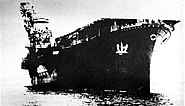Wikipedia:Main Page (2016 redesign)/Tomorrow
From tomorrow's featured article
Hiyō (Flying Hawk) was the name ship of her class of two aircraft carriers of the Imperial Japanese Navy. Begun as the ocean liner Izumo Maru in 1939, she was purchased by the Navy Ministry in 1941 for conversion to an aircraft carrier. Completed shortly after the Battle of Midway in June 1942, she participated in the Guadalcanal campaign, but missed the Battle of the Santa Cruz Islands in October because of an electrical generator fire. The carrier's aircraft were disembarked several times and used from land bases in battles in the South West Pacific. Hiyō was torpedoed in mid-1943 and spent three months under repair. She spent most of the next six months training and ferrying aircraft before returning to combat. She was sunk by a gasoline-vapour explosion caused by an American torpedo hit during the Battle of the Philippine Sea on 20 June 1944 with the loss of 247 officers and ratings, about a fifth of her complement. (This article is part of a featured topic: Hiyō class aircraft carrier.)
In the news
- American baseball player Willie Mays (pictured) dies at the age of 93.
- A fire in a residential building in Mangaf, south of Kuwait City, kills fifty people.
- A plane crash near Chikangawa, Malawi, kills nine people, including Vice President Saulos Chilima.
- In tennis, Iga Świątek wins the women's singles and Carlos Alcaraz wins the men's singles titles at the French Open.
Did you know
- ... that the Amen break (waveform pictured) gained popularity because it offered an easy way to create jungle music?
- ... that the execution of Burkinabé trade union leader Soumane Touré was prevented by the intervention of his childhood friend, then-president Thomas Sankara?
- ... that The Amazing Digital Circus is influenced by the short story "I Have No Mouth, and I Must Scream"?
- ... that Jaelyn Brown, who was born with two club feet, now plays in the WNBA?
- ... that the U.S. Department of Labor recorded 583 sitdown strikes in the U.S. between 1936 and 1939, affecting half a million workers?
- ... that Vasantha Krishna Prasad was the richest candidate from Krishna district to contest the 2019 Andhra Pradesh Legislative Assembly election?
- ... that Megan Abbott receives the most negative letters from readers for The End of Everything?
- ... that volleyball player Madisen Skinner beat Texas in one national championship final – then won two national championships with Texas?
- ... that Pizza Hut’s most expensive pizza was a weighted blanket?
On this day (June 20)
- 1837 – Queen Victoria (pictured) acceded to the British throne, beginning a 63-year reign.
- 1921 – British Army officer Thomas Stanton Lambert was assassinated by the Irish Republican Army near Moydrum, Ireland.
- 1959 – The extratropical remnants of an Atlantic hurricane reached the Gulf of St. Lawrence in Canada, causing 22 fishing boats to capsize and killing 35 people.
- 1979 – Bill Stewart, an American journalist, was executed by Nicaraguan Guardia forces.
- 1982 – The International Conference on the Holocaust and Genocide, the first major conference in genocide studies, opened despite Turkish attempts to cancel it due to the inclusion of presentations on the Armenian genocide.
- John of Lancaster (b. 1389)
- Fritz Koenig (b. 1924)
- Edith Windsor (b. 1929)
- Ulf Merbold (b. 1941)
Be an editor
Anyone can edit Wikipedia! Click the Edit tab at the top of most pages (or the [edit] link above sections) to correct errors or fix red links. If you want to take on other tasks, our introduction will guide you through the basic principles of editing.
There are many resources to help you along the way:
- Help desk – for help on editing
- Reference desk – to help you find information on any subject
- Teahouse – a help desk aimed at new editors
- Village pump – to discuss Wikipedia itself with other editors
- Community portal – for even more resources
Today's featured picture (check back later for tomorrow's)

|
The six-spot burnet (Zygaena filipendulae) is a moth of the family Zygaenidae. It is a common species throughout Europe, except the Atlantic coast of the Iberian Peninsula, northern Scandinavia and the Great Russian North, and is also present in Asia Minor, through the Caucasus to Syria and Lebanon. It inhabits meadows, woodland clearings, sea-cliffs and area rich in grasses and flowers, up to 2,000 m altitude. The adults fly on hot, sunny days and are attracted to a wide variety of flowers such as knapweed and scabious, as well as the larval food plants bird's foot trefoil, Dorycnium, Coronilla and clover. This six-spot burnet was photographed in Kulna, Estonia. Photograph credit: Ivar Leidus
Recently featured:
|
Wikipedia languages
This Wikipedia is written in English. Many other Wikipedias are available; some of the largest are listed below.
-
1,000,000+ articles
-
250,000+ articles
-
50,000+ articles
Sister projects
Wikipedia is written by volunteer editors and hosted by the Wikimedia Foundation, a non-profit organization that also hosts a range of other volunteer projects:
-
Commons
Free media repository -
MediaWiki
Wiki software development -
Meta-Wiki
Wikimedia project coordination -
Wikibooks
Free textbooks and manuals -
Wikidata
Free knowledge base -
Wikinews
Free-content news -
Wikiquote
Collection of quotations -
Wikisource
Free-content library -
Wikispecies
Directory of species -
Wikiversity
Free learning tools -
Wikivoyage
Free travel guide -
Wiktionary
Dictionary and thesaurus




